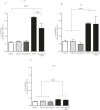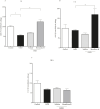Brosimine B and the biphasic dose-response: insights into hormesis and retinal neuroprotection
- PMID: 40264659
- PMCID: PMC12012618
- DOI: 10.3389/fphar.2025.1558726
Brosimine B and the biphasic dose-response: insights into hormesis and retinal neuroprotection
Abstract
Introduction: The biphasic dose-response behavior, also known as hormesis, is a characteristic feature of numerous natural products. It is defined by beneficial effects at low concentrations and toxicity at higher doses. This study investigates the hormetic effects of Brosimine B, a flavonoid derived from Brosimum acutifolium, on retinal cell viability under oxidative stress.
Methods: To simulate ischemic conditions, we used an oxygen-glucose deprivation (OGD) model. Retinal cells were treated with varying concentrations of Brosimine B, and analyses of cell viability, reactive oxygen species (ROS) production, and antioxidant enzyme activity were performed.
Results: Brosimine B at 10 µM significantly enhanced cell viability and reduced ROS production, likely through modulation of oxidative stress-protective enzymes such as catalase. However, higher concentrations (>10 µM) induced cytotoxic effects. A computational modeling approach using a hormetic (inverted U-shaped) model revealed biologically interpretable parameters, including a peak response at 10.2 µM and a hormetic zone width (σ = 6.5 µM) (R2 = 0.984).
Discussion: These results confirm that Brosimine B exhibits hormetic neuroprotective effects within a well-defined concentration window, supporting its potential as a therapeutic agent for oxidative stress-related retinal damage. The study highlights the value of computational modeling in optimizing dose-response analyses, offering a framework for refining natural product therapies and predicting toxicological thresholds in pharmacological applications.
Keywords: Brosimine b; antioxidant; hormesis; natural products; neuroprotection; oxidative stress; retinal cell.
Copyright © 2025 Fonseca, S. Port’s, Aguiar, Botelho, Couto, Pinheiro, Khayat, Yamada, Costa, Sena, Arruda, Bahia and Pereira.
Conflict of interest statement
The authors declare that the research was conducted in the absence of any commercial or financial relationships that could be construed as a potential conflict of interest.
Figures






Similar articles
-
Statistical modeling of hormesis quantities in inverted U-shaped dose-response relationships by reparameterization of a bilogistic model.J Environ Sci Health A Tox Hazard Subst Environ Eng. 2022;57(12):1003-1023. doi: 10.1080/10934529.2022.2138056. Epub 2022 Nov 26. J Environ Sci Health A Tox Hazard Subst Environ Eng. 2022. PMID: 36433811
-
The phytoprotective agent sulforaphane prevents inflammatory degenerative diseases and age-related pathologies via Nrf2-mediated hormesis.Pharmacol Res. 2021 Jan;163:105283. doi: 10.1016/j.phrs.2020.105283. Epub 2020 Nov 4. Pharmacol Res. 2021. PMID: 33160067 Review.
-
Statistical modeling of the hormetic dose zone and the toxic potency completes the quantitative description of hormetic dose responses.Environ Toxicol Chem. 2015 May;34(5):1169-77. doi: 10.1002/etc.2857. Epub 2015 Apr 7. Environ Toxicol Chem. 2015. PMID: 25523646
-
Berberine protects against 6-OHDA-induced neurotoxicity in PC12 cells and zebrafish through hormetic mechanisms involving PI3K/AKT/Bcl-2 and Nrf2/HO-1 pathways.Redox Biol. 2017 Apr;11:1-11. doi: 10.1016/j.redox.2016.10.019. Epub 2016 Nov 4. Redox Biol. 2017. PMID: 27835779 Free PMC article.
-
Preconditioning is hormesis part II: How the conditioning dose mediates protection: Dose optimization within temporal and mechanistic frameworks.Pharmacol Res. 2016 Aug;110:265-275. doi: 10.1016/j.phrs.2015.12.020. Epub 2015 Dec 31. Pharmacol Res. 2016. PMID: 26748033 Review.
Cited by
-
Assessment of Anticancer Effects of Aloe vera on 3D Liver Tumor Spheroids in a Microfluidic Platform.Biotechnol Bioeng. 2025 Sep;122(9):2592-2608. doi: 10.1002/bit.29033. Epub 2025 Jun 20. Biotechnol Bioeng. 2025. PMID: 40539369 Free PMC article.
References
-
- Belecky-Adams L., Haynes T., Wilson M., Del Rio-Tsonis K. (2008). “Chapter 8 - the chick as a model for retina development and regeneration,” in Animal models in eye research. Editor Tsonis P. A. (London: Academic Press; ), 102–119.
LinkOut - more resources
Full Text Sources

